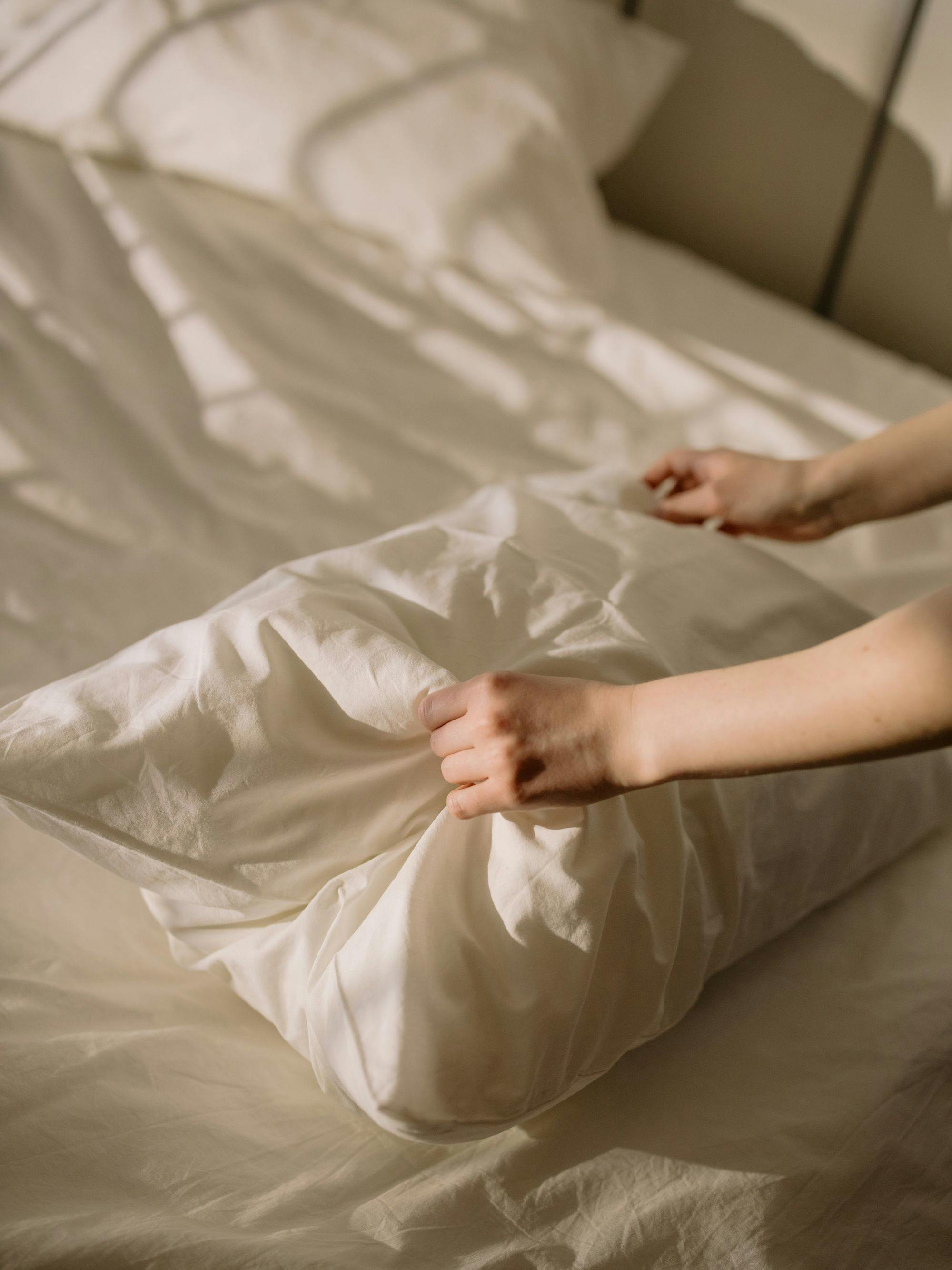Keeping your buckwheat pillow clean is essential for both its longevity and your own sleep environment.
Unlike traditional pillows, buckwheat pillows consist of a fabric casing filled with buckwheat hulls, and thus require a specific approach to cleaning.
While the outer shell or case is often washable, the buckwheat hulls inside need careful handling to avoid damage and preserve their supportive properties.
Key Takeaways
- Proper cleaning enhances the pillow's lifespan and ensures a healthy sleep environment.
- The pillow case can be washed, while the buckwheat hulls require gentle handling.
- It's crucial to thoroughly dry the case and hulls before reassembling to prevent mold.
Understanding Cleaning and Care for Buckwheat Pillows
Buckwheat pillows offer supportive, breathable comfort but require specific cleaning methods different from traditional pillows.
Washability of Buckwheat Pillows: It’s important to understand that while the outer casing is usually washable, the buckwheat hulls themselves are not. Therefore I would separate the two components before cleaning.
Cleaning the Cover
- Remove Buckwheat Hulls: Carefully empty the hulls into a large container before washing the cover.
- Wash Settings: I use a gentle cycle with cold water to prevent shrinkage of the cover.
- Drying: Avoiding the dryer, I air dry the cover to preserve fabric integrity.
Caring for the Buckwheat Hulls
- Refresh Hulls: I lay them out on a flat surface and expose them to sunlight, which naturally deodorizes and rejuvenates the hulls.
- Replacement: Over time, I may need to completely replace the hulls to maintain pillow firmness and hygiene.
Preventative measures
I also implement some preventative measures to reduce the cleaning frequency:
- Protective Pillowcases: I use a pillowcase which is easily removable and washable, providing an additional layer of protection.
By using these guidelines, I can extend the life of my buckwheat pillow and enjoy continuous comfortable sleep. It's crucial to follow the proper cleaning methods and remember that buckwheat hulls must not get wet.
Pre-Cleaning Preparation

Before beginning the cleaning process for a buckwheat pillow, it's essential to prepare adequately. This involves compiling all supplies and understanding how to handle the buckwheat hulls.
Gathering Necessary Supplies
To clean your buckwheat pillow efficiently, you’ll need specific items ready:
- Empty container: A bowl or bag to hold the buckwheat hulls.
- Pillowcase or mesh laundry bag: Useful for washing the outer cover of the pillow.
Removing the Buckwheat Hulls
Carefully remove the buckwheat hulls from the pillow by:
- Unzipping the pillow cover, if available.
- Gently pouring the hulls into your chosen container, ensuring none are left behind.
Washing the Pillow Case
When I clean my buckwheat pillow case, I start by removing it from the pillow. Buckwheat hulls, the filling of the pillow, should be set aside during this process.
I will also check the care label first, as it provides essential instructions tailored to the pillowcase’s fabric.
For washing the case, I follow these steps:
- Pre-treat any stains by applying a small amount of gentle detergent directly on them and gently rubbing the fabric together.
- Use cold water (75 to 85 degrees Fahrenheit) for washing, as hot water can cause shrinkage and fading.
- The detergent should be mild and appropriate for delicate fabrics to preserve the integrity of the case.
- I opt for a gentle cycle on my washing machine, or I can also wash the case by hand if it's recommended or if I prefer to be extra cautious.
After washing, I dry the pillow case properly:
- I avoid the dryer, instead, I lay the case flat to air dry.
- If needed, I also hang the pillowcase on a clothesline but keep it out of direct sunlight to prevent any color fading.
Throughout the process, I’m careful to treat the buckwheat pillow case gently to maintain its quality and extend its longevity. Regular cleaning, as indicated on the product’s care instructions, helps keep the pillowcase fresh and hygienic.
Reassembling the Pillow
After cleaning, we need to put the buckwheat pillow back together, ensuring it’s as supportive and comfortable as when it was new. This involves a careful process of refilling and distribution of the buckwheat hulls.
Refilling With Buckwheat Hulls
I start by opening the pillowcase or liner where the buckwheat hulls were initially housed. I make sure it's thoroughly dry before reintroducing the hulls.
Using a funnel or a spout, I carefully pour the buckwheat hulls back into the pillowcase. It's important to do this over a clean surface to avoid spillage and potential waste.
Ensuring Even Distribution
Once all the buckwheat hulls are back inside the pillow, I zip the case securely and then begin to distribute the hulls evenly. This step is crucial for comfort and the overall longevity of the pillow.
I gently shake and massage the pillow, feeling for clumps or uneven areas. It may take a few minutes, but I ensure the hulls are spread out evenly. My goal is a smooth, uniform surface that will cradle my head perfectly as I sleep.
Spot Cleaning
When I notice a spill or spot on my buckwheat pillow, prompt action is important to prevent setting the stain. I always use gentle methods to ensure the integrity of the buckwheat hulls and the pillow casing.
Treating Stains
To treat a stain on my buckwheat pillow, I first remove the hulls and set them aside. I then focus on the stain directly on the fabric casing.
I make a mild solution of water and detergent, dabbing it onto the spot with a clean cloth. It's crucial not to drench the casing; rather, I blot gently to lift the stain.
Drying the Spot Cleaned Areas
After treating the stain, I thoroughly air dry the area, away from direct sunlight and heat sources. If possible, I allow for natural ventilation to facilitate the drying process.
It's also important that I make sure the stained area is completely dry before refilling the pillow with buckwheat hulls to prevent any mold or mildew growth.
Maintaining Buckwheat Pillow Cleanliness
Maintaining the cleanliness of my buckwheat pillow is essential to ensure its longevity and my comfort during sleep.
I'll share specific tips and techniques that I employ to keep my pillow fresh.
Regular Maintenance Tips
- Pillowcase Usage: I always keep my buckwheat pillow encased in a pillowcase, which I wash weekly. This provides an extra layer of protection against oils, sweat, and dust.
- Spot Cleaning: If spills occur, I address them immediately by spot cleaning with a damp cloth and a mild detergent, ensuring not to soak the buckwheat hulls.
- Avoid Moisture: I'm careful to shield my pillow from moisture, as wet hulls can lead to mold or unpleasant odors.
- Air Out Regularly: About once a month, I air out my buckwheat pillow in indirect sunlight to prevent moisture buildup and to eliminate odors.
Refreshing the Buckwheat Hulls
- Replacement: Every year, I assess the condition of my buckwheat hulls. If they begin to break down, I replace them with fresh hulls to maintain the pillow's support and cleanliness.
- Oven Refresh: Occasionally, I'll place the hulls on a baking sheet and put them in the oven at a very low temperature for a short time. This helps to remove moisture and makes the hulls feel revitalized. Always be careful to not overheat, as this could pose a fire risk.
Storage and Care for Longevity
Properly cared and maintained buckwheat pillow can last for up to one or two decades. To maintain the quality of a buckwheat pillow and ensure its longevity, I follow specific storage and care guidelines.
Firstly, regular maintenance is essential:
- To remove dust and preserve the hulls' structure, I lightly vacuum the pillow using a hose attachment.
- I always remove the buckwheat hulls before cleaning the pillowcase or cover.
- When not in use, I store the pillow in a cool, dry place to prevent moisture build-up which can lead to mold.
For the pillowcase and cover:
- Machine wash on a gentle cycle with mild detergent.
- Air dry thoroughly to avoid any dampness.
Here's a quick table for the care routine:
| Action | Frequency | Notes |
|---|---|---|
| Fluff Pillow | Daily | Maintains shape |
| Wash Cover | As needed | Use mild detergent |
| Air out Hulls | Monthly | Ensures freshness |
| Replace Hulls | Every few years | Replace hulls as they begin to break down |
Remember, the buckwheat hulls themselves should not be washed as this can compromise their integrity. Instead, airing them out periodically can help maintain their freshness.
If they do get wet, dry them thoroughly in a sunny spot to prevent any mold growth. Should the hulls begin to degrade, they are easily replaceable.
YZ Li
YZ, an engineer with a PhD based in the San Francisco Bay Area, brings practical expertise to Restful Guides. Focused on simple, effective ways to improve sleep and relaxation, YZ offers easy-to-follow advice on choosing the right pillows, bedding, and meditation techniques for a better, more restful life.
